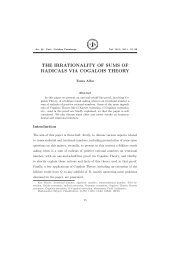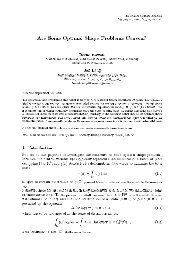258 Dirk Segersr <strong>number</strong>s l k − n are <strong>the</strong> real parts <strong>of</strong> <strong>the</strong> poles <strong>of</strong> Z f (s). If we denote <strong>the</strong>elements <strong>of</strong> V by 1, . . . , r in such a way that l k − n = −a k /b k for everyk ∈ {1, . . . , r}, we have for k ∈ {1, . . . , r} that1. <strong>the</strong> function g k (i) is <strong>polynomial</strong> on each residue class modulo b k ,2. <strong>the</strong> maximum <strong>of</strong> <strong>the</strong> degrees <strong>of</strong> <strong>the</strong>se <strong>polynomial</strong>s is equal to m k − 1 and3. <strong>the</strong>se <strong>polynomial</strong>s (and thus also g k (i)) are determined by <strong>the</strong> principalparts <strong>of</strong> <strong>the</strong> Laurent series <strong>of</strong> Z f (s) in <strong>the</strong> poles with real part −a k /b k .Remark. (1) <strong>The</strong> l k are rational <strong>number</strong>s less than n because <strong>the</strong> real parts <strong>of</strong><strong>the</strong> poles <strong>of</strong> Z f (s) are negative rational <strong>number</strong>s. <strong>The</strong> author proved in [Se3]that <strong>the</strong> real part <strong>of</strong> every pole <strong>of</strong> Z f (s) is larger than or equal to −n/2. Thisimplies that l k ≥ n/2 for every k ∈ {1, . . . , r}. Moreover, in <strong>the</strong> case thatn = 3 and f has no singular point in Z 3 p <strong>of</strong> multiplicity 2, <strong>the</strong> author proved[Se2] that <strong>the</strong>re are no poles with real part less than −1, which implies thatl k ≥ 2 for every k ∈ {1, . . . , r}.(2) It follows from <strong>the</strong> <strong>the</strong>orem that <strong>the</strong> <strong>asymptotic</strong> <strong>behaviour</strong> <strong>of</strong> <strong>the</strong> <strong>number</strong><strong>of</strong> <strong>solutions</strong> is determined by <strong>the</strong> largest real part <strong>of</strong> a pole <strong>of</strong> Z f (s) andby <strong>the</strong> largest order <strong>of</strong> a pole with maximal real part.Pro<strong>of</strong>. Applying decomposition into partial fractions in Q[t], we can writeP (t) = C 0 (t) + ∑ k∈VC k (t)(1 − p −a k tb k) m k,where every C k (t) ∈ Q[t] and where deg(C k (t)) < m k b k for k ∈ V . Note that<strong>the</strong> term C 0 (t) does not give a contribution to M i for i > deg(C 0 (t)) and thatdeg(C 0 (t)) = deg(P (t)) if one <strong>of</strong> <strong>the</strong>m is non-negative. Now we look at <strong>the</strong>contributions <strong>of</strong> <strong>the</strong> o<strong>the</strong>r terms. So fix k ∈ V . Note that C k (t) containsexactly <strong>the</strong> information <strong>of</strong> <strong>the</strong> principal parts <strong>of</strong> <strong>the</strong> Laurent series <strong>of</strong> P (t) at<strong>the</strong> poles with absolute value p a k/b k. We haveC k (t)(1 − p −a k tb k) m k===C k,mk (t) C k,mk −1(t)(1 − p −a +k tb k) m k (1 − p −a k tb k) m k −1 + · · · + C k,1(t)1 − p −a k tb kb∑k −1 ∞∑g k,d (e)p −ea kt eb k+dd=0 e=0b∑k −1d=0 e=0∞∑g k,d (e)p da k/b k p (n−a k/b k )(eb k +d) teb k+dp ,n(eb k+d)
<strong>The</strong> <strong>asymptotic</strong> <strong>behaviour</strong> <strong>of</strong> <strong>the</strong> <strong>number</strong> <strong>of</strong> <strong>solutions</strong> <strong>of</strong> <strong>polynomial</strong>... 259where C k,l (t) ∈ Q[t] with deg(C k,l (t)) < b k and where <strong>the</strong> maximum <strong>of</strong> <strong>the</strong>degrees <strong>of</strong> <strong>the</strong> <strong>polynomial</strong>s g k,d (e) is equal to m k − 1. Actually, if we denote<strong>the</strong> coefficient <strong>of</strong> t d in C k,l (t) by C k,l,d , we get(e + m k − 2)!g k,d (e) = C k,mk ,d(e − 1)!(m k − 1)! +C (e + m k − 3)!k,m k −1,d(e − 1)!(m k − 2)! +· · ·+C k,1,d.□(2.2) Finally, we give two examples. In <strong>the</strong> first example, all <strong>the</strong> coefficients<strong>of</strong> <strong>the</strong> <strong>polynomial</strong>s C k (t), k ∈ V , are in S. This is in some sense <strong>the</strong> easiestsituation. <strong>The</strong> second example shows that this is not always <strong>the</strong> case. <strong>The</strong>reare several ways to compute <strong>the</strong> Poincaré series: one can calculate <strong>the</strong> integralon an embedded resolution <strong>of</strong> singularities <strong>of</strong> f, one can use <strong>the</strong> formula for<strong>polynomial</strong>s which are non-degenerated over F p with respect to <strong>the</strong>ir Newtonpolyhedron [DH] and one can use <strong>the</strong> p-adic stationary phase formula [Ig2,<strong>The</strong>orem 10.2.1]. All <strong>the</strong>se techniques are also explained in [Se1, Section 1.1].Example 1. Let f(x, y) = y 2 − x 3 and let p be an arbitrary prime. <strong>The</strong>n,P (t) = −t6 + p 4 t 2 − p 3 t 2 + p 6(p 5 − p 6 )(p − t)= 2p−5 t 5 + 2p −4 t 4 + 2p −3 t 3 + 2p −2 t 2 + (p + 1)p −2 t + (p + 1)p −11 − p −5 t 6= − p−11 − p −1 t .We obtain for every e ∈ Z ≥0 thatM 6e = (p + 1)p 7e−1 − p 6e−1 , M 6e+1 = (p + 1)p 7e − p 6e ,M 6e+2 = 2p 7e+2 − p 6e+1 , M 6e+3 = 2p 7e+3 − p 6e+2 ,M 6e+4 = 2p 7e+4 − p 6e+3 and M 6e+5 = 2p 7e+5 − p 6e+4 .Example 2. Let f(x, y) = x 3 + y 5 and let p be an arbitrary prime. <strong>The</strong>n,P (t) ==−t 15 + (p − 1)t 14 + (p − 1)pt 12 + (p − 1)p 3 t 9+(p − 1)p 3 t 8 + (p − 1)p 5 t 5 + (p − 1)p 6 t 3 + (p − 1)p 6 t 2 + p 9(p 8 − t 15 )(p − t)C 1 (t)1 − p −8 t 15 + C 2(t)1 − p −1 t ,






